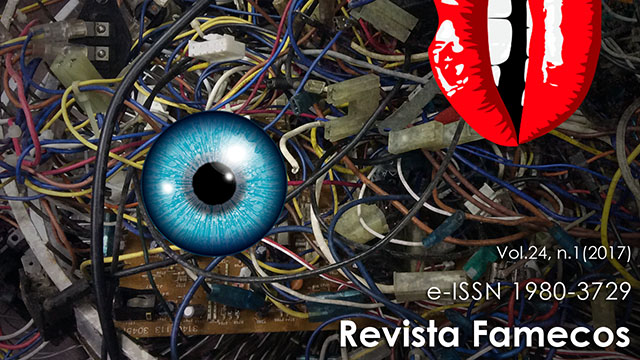Black as sign of quality and distinction in food packaging communication
DOI:
https://doi.org/10.15448/1980-3729.2017.1.23706Keywords:
Color symbolism, Visual communication, Packaging designAbstract
This research discusses the symbolic content broadcasted on food packaging communication, focusing on the role played by colors in constructing visual messages. It is based on doctoral research in which packages of ten distinct colors were examined. The color language was investigated as a sign system. The study was based on Saussurre theory as well as on classifications and analysis models proposed by Peirce and by Groupe µ. This article is a cutout of the color spectrum examined in the thesis, describing the results for black color and analyzing its symbolic role in the construction of product’s high quality image. It is concluded that black packaging and labels reflect developments of mass taste for luxury in processed foods consumption, reproducing signs of social distinction.Downloads
References
BARTHES, Roland. Elementos de semiologia. São Paulo: Cultrix, 2006.
BATCHELOR, David. Cromofobia. São Paulo: Senac, 2007.
BENCH MARK DESIGN. Embalagem de vinagre balsâmico. Disponível em: http://www.bench.com.br/balsamico.html
Acesso em: 03 mar. 2014.
BERLIN, Brent; KAY, Paul. Basic color terms: their universality and evolution. Los Angeles: University of California Press, 1991.
BOURDIEU, Pierre. A distinção: crítica social do julgamento. São Paulo: Edusp, 2008.
BUCCHETTI, Valeria. La messa in scena del prodotto. 2. ed., Milano: Franco Angeli, 2002.
_____. Packaging design: storia, linguaggi, progetto. Milano: Franco Angeli, 2005.
CAIVANO, José Luis. Color and semiotics: a two-way street. Color Research and Application, v. XXIII, 6 Dec. 1998.
CAVASSILAS, Marina. Clés et codes du packaging. Paris: Lavoisier, 2007.
ENDT, Evert ; GRANDADAM, Sabine. Design for everyday objects. In: Jocelyn de Noblet (Ed.). Industrial Design: reflection of a century. Paris: Flammarion, p. 30-36, 1993.
FISCHLER, Claude. L’homnivore: le goût, la cuisine et le corps. Paris: Odile Jacob, 2001.
FERRARESI, Mauro. Il packaging. Milano: Franco Angeli, 2003.
GAGE, John. 1993. Colour and culture: practice and meaning from antiquity to abstraction. London: Thames and Hudson, 1993.
GALLO. Embalagem de azeite de oliva. Disponível em: http://www.gallooliveoil. com/br/produtos.aspx
Acesso em: 13 set. 2011.
GROUPE μ. Tratado del signo visual: para una retórica de la imagem. Madrid: Catedra, 1993.
HARVEY, John. Homens de preto. São Paulo: Unesp, 2003.
HELLER, Eva. Psicología del color: cómo actúan los colores sobre los sentimientos y la razón. Barcelona: Gustavo Gili, 2004.
JOHN WALKER & SONS. Código de cores para whisky de 1906. Disponível em: http://www.keepwalking.pt
Acesso em: 24 mar. 2011.
KOZAC, Gisela; WIEDEMANN, Julius. Package design now! Köln: Tashen, 2008.
LIPOVETSKY, Gilles e ROUX, Elyette. O luxo eterno: da idade do sagrado ao tempo das marcas. São Paulo: Companhia das Letras, 2005.
LUZZATTO, Lia; POMPAS, Renata. I colori del vestire. Milano: Hoepli, 1997.
MULLER CAMACHO DESIGN. Embalagem de água mineral. Disponível em: http://www.mullercamacho.com.br Acesso em: 20 abr. 2011.
PASTOUREAU, Michel. Colour, design and mass consumption: the history of a difficult encounter (1880-1960). In: Jocelyn de Noblet (Ed.). Industrial Design: reflection of a century. Paris: Flammarion, p. 336-341, 1993a.
_____. Dicionário das cores do nosso tempo: simbólica e sociedade. Lisboa: Editorial Estampa, 1993b.
_____. Preto: história de uma cor. São Paulo: Editora Senac, 2011.
PEIRCE, Charles S. Semiótica. São Paulo: Perspectiva, 1995.
PEPSICO Inc. Embalagem de salgadinho de batata. Disponível em: http://www.pepsico.com.br/elma-chips-sensacoes
Acesso em: 17 fev. 2014.
PERI, Claudio. The universe of food quality. Food Quality and Preference, v. 17, p. 3-8. 2006. Disponível em: http://www.sciencedirect.com
Acesso em: 25 mai. 2009.
RILEY, Charles A. Color codes: modern theories of color in philosophy, painting and architecture, literature, music and psychology. London: University Press of New England, 1995.
SAUSSURE, Ferdinand. Curso de linguística geral. São Paulo: Cultrix, 2012.
Downloads
Published
How to Cite
Issue
Section
License
Copyright
The submission of originals to Revista Famecos implies the transfer by the authors of the right for publication. Authors retain copyright and grant the journal right of first publication. If the authors wish to include the same data into another publication, they must cite Revista Famecos as the site of original publication.
Creative Commons License
Except where otherwise specified, material published in this journal is licensed under a Creative Commons Attribution 4.0 International license, which allows unrestricted use, distribution and reproduction in any medium, provided the original publication is correctly cited.






